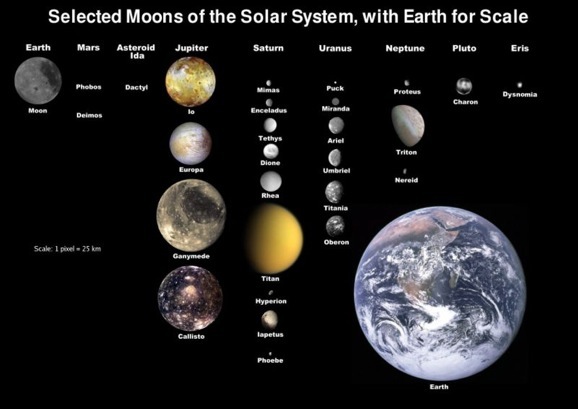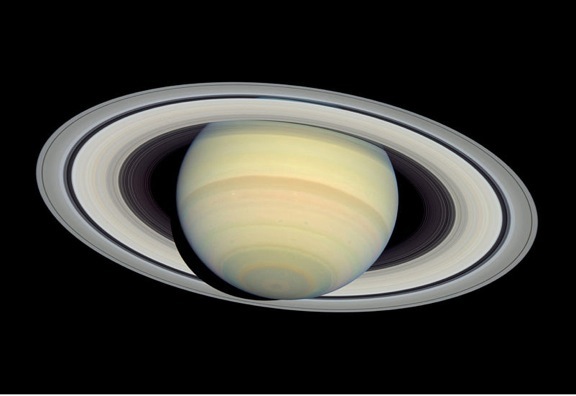



What if the moons weren't stable?
In all there are two hundred and forty bodies in the solar system that classify as moons. They all exist in stable orbits with their primaries, orbits that became stable billions of years ago. But what if they weren't ...
The following picture shows some of the many moons of the solar system. The four largest moons: Ganymede, Callisto, Titan and Io orbit the gas giants Jupiter and Saturn. Luna, Earth's own moon, is the fifth largest moon in the solar system, but she is by far the largest moon to orbit a rocky planet (more on this later).
Image provided by NASA (and therefore not copyrighted). Obtained from the WikiMedia Commons.
All these moons are in stable orbits, but there is evidence of catastrophic interactions having occurred in the solar system during its early days (approximately 4.5 billion years ago), the most obvious being the rings of Saturn which are believed to be the remnants of a moon that was ripped apart by tidal interaction with Saturn and which have spread out along its orbital path to completely encircle the planet (Note: Jupiter also has its rings, presumably formed the same way, but they are nowhere near as prominent as those of Saturn).
Image provided by NASA (and therefore not copyrighted). Obtained from the WikiMedia Commons.
And the Earth itself was not immune from these dramatic events. It is believed that our Moon was created by a massive impact on the Earth by a body about the size of Mars shortly (about 30 million years) after the Earth itself coalesced out of the dust cloud from which the sun formed. This caused a great glob of matter to be sheared away with enough force that it reached escape velocity and eventually entered a stable orbit around the larger mass. Gravitation then caused both masses of molten material to collapse into the roughly spherical shapes we know today. This explains why the Moon is so large compared to the Earth.
From the ruins.
So, the Moon was born of the Earth and has been with us more or less from the beginning, and there's no denying that is has an effect on both the planet and ourselves in one way or another. There are even theories that without the early Moon causing drastic fluctuations in sea levels through its tidal effect (the moon has been slowly moving away from the Earth) that life wouldn't have formed on Earth at all (see reference below). I would like to extend that argument to suggest that some of the biodiversity of the Earth is due to the influence of our nearest neighbour, and especially its size in relation to the planet.
One thing speculative fiction writers should take away from this is that for a moon to have much of an effect on its primary it has to be a significant fraction of the size of the planet. This would apply to both physical and metaphysical effects. Remember, the Moon is the second brightest object in our sky and I doubt that it would be anywhere near as important if it weren't such an obvious feature in the heavens.
Worlds in Collision
I feel I would be remiss if I didn't mention the work of Immanuel Velikovsky here at the end of this series of articles, for although he was not dealing with multiple moons, the scope of his ideas should provide lots of material for speculative fiction writers.
His theories, became popular in the 1950s with the release of his first book on the subject, "Worlds in Collision", in which he postulated that the great catastrophes that are mentioned in the earliest human records were actually caused by planetary movements within the solar system. According to his theory, Venus was originally a moon of Jupiter which was ejected from its orbit and sailed close to Earth about 1500 BCE before taking up a stable orbit closer to the sun.
Velikovsky's ideas were not accepted by the scientific community, they being impossible considering the laws of Physics as we know them, but the book is a very interesting read and it does show some interesting correlations in the historic records.
Well, that's enough about multiple moons. I hope you found it interesting.
References:
An overview of the Solar System’s moons
http://en.wikipedia.org/wiki/Natural_satellite
Formation of the rings of Saturn
http://en.wikipedia.org/wiki/Rings_of_Saturn#Formation
If We Had No Moon
http://astrobio.net/news/modules.php?op=modload&name=News&file=article&sid=2507&mode=thread&order=0
"Worlds in Collision" by Immanuel Velikovsky
http://en.wikipedia.org/wiki/Worlds_in_Collision
N.B. Please note that I although I use the Wikipedia (and WikiMedia Commons) a lot for references, this is for expediency and the familiarity of my readers. Anyone interested in further studies should make use of the references where available and understand that the Wikipedia is a co-operative project contributable to by anyone and must always be looked at in that light.
Phill Berrie, September, 2008.




